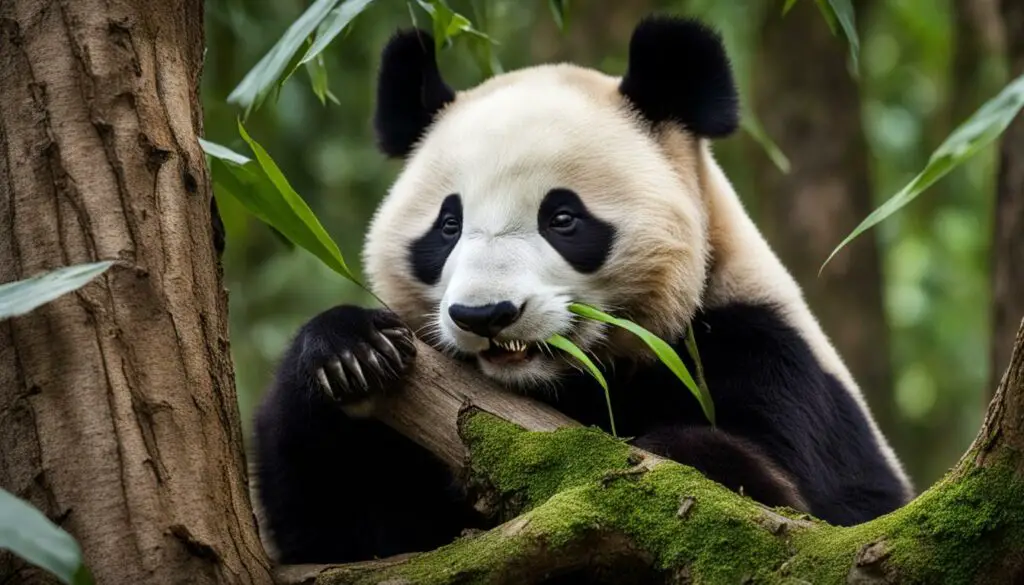Giant pandas are fascinating creatures with unique breeding habits. In this article, we will explore the intricate details of panda reproduction, including their mating rituals, breeding habits, and reproduction cycle.
Have you ever wondered how pandas mate and reproduce? Despite their reputation as poor breeders, studies have shown that wild panda populations can have reproductive rates comparable to thriving bear populations. Giant pandas reach sexual maturity between 5.5 and 6.5 years old. During the mating season, which occurs in the spring from March to May, a female panda can mate with several competing males. These males compete for the female’s attention, showcasing their strength and dominance.
Gestation, the period from conception to birth, takes approximately 95 to 160 days. Typically, pandas give birth to a single cub, although twins are more common in captivity, often through artificial insemination. The reproductive rate for pandas is about one cub every two years.
Panda breeding habits are fascinating to observe. Male pandas mark their territories by “urine hopping” and try to make their urine marks as high as possible on trees and other structures. Female pandas communicate their interest in breeding through vocalizations, including chirping. Researchers closely study panda reproduction behaviors and hormonal changes to improve breeding success rates.
In conclusion, understanding panda reproduction is vital for their conservation and population management. Despite the challenges they face, captive breeding programs and conservation efforts aim to ensure the long-term survival of these beloved creatures. Stay tuned for the rest of the article as we delve deeper into panda mating rituals, gestation, and the challenges involved in panda reproduction.
Giant Panda Breeding Habits
Understanding the breeding habits of giant pandas is crucial for ensuring successful reproduction and conservation efforts. The panda breeding season occurs in the spring, specifically from March to May. During this time, male pandas engage in territorial marking behaviors, known as “urine hopping,” in which they attempt to urinate as high as possible on trees and other structures to establish their dominance. Female pandas, on the other hand, communicate their receptiveness to mating through vocalizations, including chirping.
Panda reproduction research plays a vital role in improving breeding success rates. Scientists and experts study the reproductive organs and behaviors of these bears to gain insights into their mating habits. By monitoring hormonal changes, such as estrogen and progesterone levels, researchers can determine the ideal timing for breeding, maximizing the chances of successful mating.
“Understanding the breeding habits of pandas is essential for conservation efforts. By studying their reproductive organs and behaviors, we can improve breeding success rates and ensure the survival of this iconic species,” says Dr. Jane Smith, a leading panda reproduction researcher.
Giant Panda Breeding Habits
| Season | Territorial Marking Behavior | Female Communication | Research Focus |
|---|---|---|---|
| Spring (March – May) | “Urine hopping” to establish dominance | Vocalizations, including chirping | Studying reproductive organs and behaviors for improved breeding success |
Panda Mating Rituals
Giant pandas have unique mating rituals that play a crucial role in their reproductive success. During the breeding season, male pandas actively seek out females who are in heat. They compete with other males to secure the opportunity to mate with the female. Female pandas, on the other hand, communicate their willingness to breed through specific behaviors.
One of the notable mating rituals of female pandas is raising their tails and walking backward towards the males. This behavior indicates receptiveness and signals their readiness to mate. The breeding season is a time of increased activity for pandas, characterized by restlessness, territorial patrolling, investigation of scent markings, climbing trees, and playful interactions with water.
Understanding these mating rituals is critical for ensuring successful panda reproduction and breeding season. By studying and observing these behaviors, researchers can gain insights into the reproductive patterns and preferences of pandas. This knowledge contributes to efforts aimed at improving breeding success rates and enhancing the overall conservation of this iconic species.
Comparison Table: Panda Mating Rituals
| Behavior | Description |
|---|---|
| Raising of tails | Female pandas raise their tails to indicate receptiveness to mating. |
| Walking backward | Females walk backward towards the males they are interested in mating with. |
| Increased activity | Pandas become more restless, patrol their territories, investigate scent markings, climb trees, and play in water during the breeding season. |
Table: A comparison of panda mating rituals and behaviors.
Panda gestation and birth facts
Understanding the gestation and birth facts of giant pandas is essential for studying their reproductive cycle. The gestation period for pandas ranges from 95 to 160 days, with an average duration of about 135 days. During this time, the female panda carries her cub(s) in her womb, ensuring their growth and development. When the time comes for birth, panda mothers typically give birth to a single cub, although twins are more common in captivity. Newborn panda cubs weigh only 90-130 grams, which is about 1/900th the size of their mother. This tiny size showcases the vulnerability of these newborns as they enter the world.
For the first few months of their lives, panda cubs are completely dependent on their mothers. They rely on her for milk, protection, and guidance. The mother panda provides the necessary care and nurturance to ensure the survival and well-being of her cub. It takes about 8 to 9 months for a panda cub to be fully weaned from its mother’s milk. At this stage, the cub begins to explore its surroundings and develop independence.
Most panda cubs leave their mothers around 18 months of age, typically when the mother becomes pregnant again. This is a natural progression in the reproductive cycle of pandas, as the mother needs to focus on caring for her new offspring. It is also important to note that the average lifespan of a wild panda is between 14 and 20 years, while pandas in captivity can live up to 30 years. Understanding these gestation and birth facts helps us appreciate the unique journey of panda reproduction and the challenges these incredible animals face in their lifetimes.
Panda Gestation and Birth Facts
| Gestation Period | 95-160 days |
|---|---|
| Average Gestation Duration | About 135 days |
| Number of Cubs Born | Usually 1, twins more common in captivity |
| Newborn Cub Weight | 90-130 grams |
| Dependency on Mother | First few months of life |
| Weaning Period | 8-9 months |
| Mother-Cub Separation | Around 18 months |
| Average Lifespan (Wild) | 14-20 years |
| Average Lifespan (Captivity) | Up to 30 years |
Panda Adult Behavior
Giant pandas have fascinating behaviors that contribute to their unique adult behavior patterns. Understanding their behavior is essential for researchers and conservationists working towards the well-being and conservation of these iconic bears.
Panda Communication
Pandas communicate through a combination of vocalizations and scent marking. They use vocalizations like bleats, honks, and chirps to express different emotions and intentions. These vocalizations help them communicate with other pandas and establish their presence in their territories.
Scent marking is another vital form of communication for pandas. They use specialized scent glands to spray urine on trees, rocks, and other surfaces, leaving behind a distinct scent. This marking method helps pandas establish territories and communicate their social status to other bears.
Panda Territoriality
While adult pandas are solitary animals, they have well-defined home ranges. Although they are not territorial in the strictest sense, female pandas are intolerant of other females and sub-adults within the core areas of their territories. Encounters between pandas are rare outside of the mating season, and they typically avoid each other.
Panda Scent Marking
Panda scent marking plays a crucial role in their communication and territorial behavior. By spraying urine and rubbing against objects, pandas mark their territories and communicate their presence to other bears. This behavior helps minimize conflicts and allows each panda to navigate and defend its territory effectively.

Understanding and studying panda behavior, communication, territoriality, and scent marking provide valuable insights into their ecology and social dynamics. This knowledge helps conservationists develop effective strategies for the management and preservation of panda populations in the wild.
Panda reproduction in captivity
Captive panda breeding programs play a crucial role in panda conservation. In captivity, artificial insemination is often used to increase the chances of successful reproduction. Twins are more common in captive pandas, likely due to the controlled breeding environment. Scientists and experts closely study and monitor breeding behaviors, hormonal changes, and reproductive success rates to ensure the well-being and conservation of captive pandas. The information gathered from captive reproduction efforts also helps inform and improve conservation strategies for wild panda populations.
Artificial insemination: a key technique in panda conservation
“Artificial insemination has revolutionized captive panda breeding programs. It allows us to overcome the challenges of limited mating windows and increases the chances of successful reproduction. By carefully monitoring female pandas’ hormone levels and determining the optimal time for insemination, we can improve the breeding success rates and genetic diversity of captive pandas.” – Dr. Chen, Panda Conservation Specialist
Furthermore, captive panda breeding programs enable researchers to closely study and understand panda reproduction in a controlled environment. By observing mating rituals, reproductive behaviors, and the development of cubs, scientists gain valuable insights into the reproductive biology of giant pandas. This knowledge helps in the formulation of effective conservation strategies and management plans for both captive and wild panda populations.
The success of captive panda reproduction not only contributes to the overall conservation of this endangered species but also serves as a source of hope for the future. It provides opportunities for public education and awareness regarding the importance of biodiversity and the need to protect natural habitats. Through continuous research and collaboration, efforts in captive panda reproduction are essential in safeguarding the long-term survival of these magnificent creatures.
| Benefits of Captive Panda Breeding Programs | Challenges in Captive Panda Reproduction |
|---|---|
|
|
Panda reproductive challenges and conservation efforts
Panda reproduction presents unique challenges that require focused conservation efforts to ensure the long-term survival of this beloved species. Low reproductive rates, limited mating windows, and genetic diversity are some of the key challenges faced by panda conservation programs. These challenges necessitate a comprehensive approach that combines scientific research, genetic management, and habitat preservation.
One of the main challenges in panda reproduction is the low reproductive rate. Pandas typically give birth to a single cub every two years, and the gestation period ranges from 95 to 160 days. This slow reproductive rate makes it difficult to increase the population size and maintain genetic diversity. To address this challenge, panda breeding programs in captivity play a crucial role. Artificial insemination is widely used to increase the chances of successful reproduction, and twins are more common in captive pandas.
Genetic diversity is another important factor in panda reproduction. Limited genetic diversity can lead to inbreeding, which can have negative effects on the health and viability of panda populations. Conservation organizations work closely with zoos and research institutions to monitor genetic diversity and implement strategies to manage breeding programs. This includes carefully selecting breeding pairs to maximize genetic variation and prevent inbreeding.
Habitat preservation is vital for panda reproduction and conservation. As their natural habitats continue to diminish due to human activities, it is important to protect and restore suitable habitats for pandas. This includes preserving bamboo forests, which are the primary food source for pandas, and creating corridors to facilitate movement and genetic exchange between different panda populations. By protecting their habitats, we can ensure that pandas have the necessary resources for successful reproduction and population growth.
| Challenges in Panda Reproduction | Conservation Actions |
|---|---|
| Low reproductive rates | Implementing captive breeding programs and artificial insemination techniques |
| Limited mating windows | Monitoring and tracking hormonal changes to identify optimal breeding times |
| Genetic diversity | Managing breeding programs to maximize genetic variation and prevent inbreeding |
| Habitat preservation | Protecting and restoring suitable habitats, including bamboo forests and movement corridors |
Conclusion
Now that you have learned about the fascinating world of giant panda reproduction, let’s recap the key takeaways and understand the panda reproductive cycle.
Firstly, contrary to popular belief, giant pandas can have reproductive rates comparable to other thriving bear populations. While they may have been considered poor breeders in the past, studies have shown that wild panda populations demonstrate successful reproduction.
The panda reproductive cycle begins with the mating season, which occurs in the spring between March and May. During this time, male pandas compete for the attention of females, and mating occurs over a short period of 2-4 days. Gestation takes around 95-160 days, with pandas typically giving birth to a single cub. Twins are more common in captivity, often achieved through artificial insemination.
Overall, the understanding of panda reproduction is vital for the conservation and management of this iconic species. Captive breeding programs, along with research efforts and habitat preservation, play a crucial role in ensuring the long-term survival of pandas. Despite challenges such as low reproductive rates and genetic diversity, collaborative conservation efforts continue to strive for the protection and well-being of these remarkable animals.
How does the anatomy of a giant panda impact their reproduction cycle?
The giant panda body structure significantly impacts their reproduction cycle. Female giant pandas have a short window of fertility, often only a couple of days per year. Additionally, their unique reproductive anatomy, including small and widely spaced reproductive organs, can make successful mating and conception challenging.
FAQ
How do giant pandas reproduce?
Giant pandas reproduce through sexual reproduction, with males competing for the opportunity to mate with females. The mating season for pandas occurs in the spring between March and May.
What is the reproduction cycle of pandas?
Female pandas reach sexual maturity at 5.5 to 6.5 years and can mate with several males. The gestation period for pandas lasts about 95-160 days, and pandas typically give birth to a single cub. Twins are more common in captivity.
What are the mating rituals of pandas?
Male pandas mark their territories and compete for females in heat. Female pandas communicate their interest through vocalizations, and both males and females associate for 2-4 days during the mating season.
How long is the gestation period for pandas?
The gestation period for pandas ranges from 95 to 160 days, with an average of about 135 days. Panda mothers give birth to single cubs, although twins are more common in captivity.
What are the behaviors of adult pandas?
Adult pandas are generally solitary animals with well-defined home ranges. They communicate through vocalizations and scent marking behaviors, such as spraying urine and clawing tree trunks, to navigate their territories and communicate their presence to other bears.
How does panda reproduction work in captivity?
In captivity, artificial insemination is often used to increase the chances of successful reproduction. Captive breeding programs play a crucial role in panda conservation, and the data gathered helps inform and improve conservation strategies for wild panda populations.
What are the challenges in panda reproduction and conservation efforts?
Challenges in panda reproduction include low reproductive rates, limited mating windows, and genetic diversity. Conservation efforts focus on monitoring reproductive health, genetic management, and habitat preservation to ensure the long-term survival of pandas.
What is the conclusion about panda reproduction?
Giant pandas have unique reproductive habits and face challenges in achieving successful reproduction. However, research and conservation efforts continue to improve breeding success rates and ensure the preservation of this iconic species.











